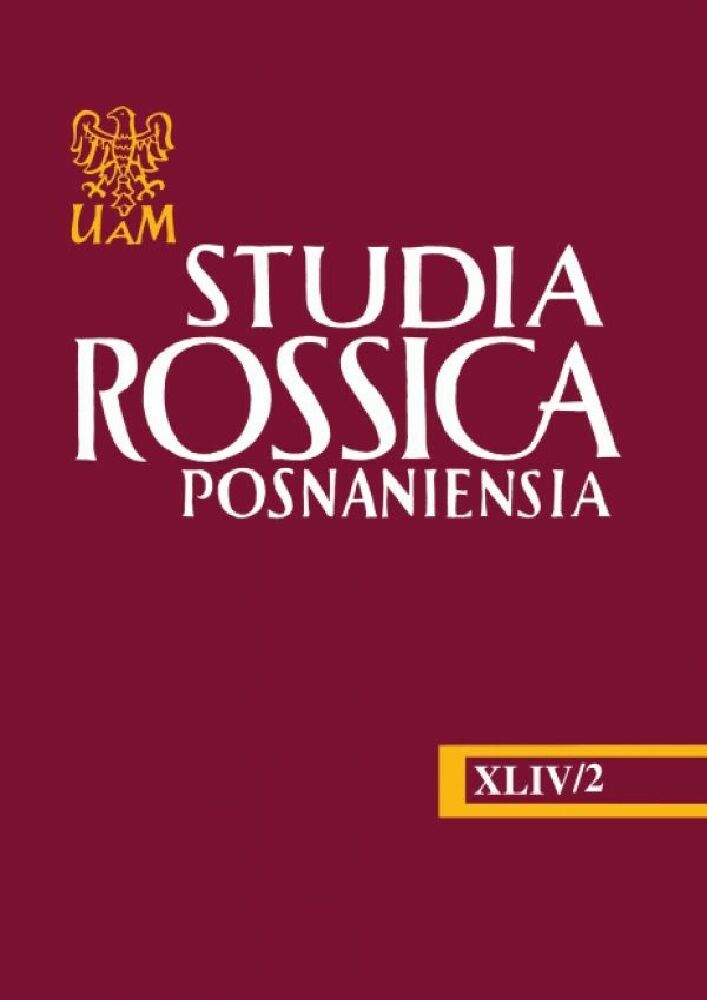Abstrakt
Artistic space, presented in the story Kabala by A. Potyomkin, can be seen in various hypostases. The real, ethereal and ill-fated areas of the imagination of the main character connect with his opium dependence. Parfirchikov’s imagination is tightly connected with nostalgia, which manifests itself in the escape from the real world into the dreamed space of his inner world. Every character’s transformation from one space into another takes place after the dose of drug is taken by him.Bibliografia
Бойм C. 2002. Общие места. Мифология повседневной жизни, Москва: Новое литературное обозрение.
Есин А. Б. 2011. Психологизм русской классической литературы, Москва: Флинта.
Лихачев Д. С. 1970. Человек в литературе древней Руси, Москва: Наука.
Потемкин А. 2011. Кабала, электронный ресурс: http://loveread.ec/read_book. php?id=38231&p=2 (доступ 17.03.2017).
Пыхтина Ю. 2014. Структура художественного пространства в повести А. П. Потемкина „Я”, электронный ресурс: http://gisap.eu/ru/node/22402 (доступ 17.06.2017).
Савельева В. В. 1999. Художественная антропология, Алматы: Алматинский Государственный университет им. Абая.
Сартр Ж.-П. 2001. Воображаемое. Феноменологическая психология воображения, перeвод с фр. M. Бекетовой, Санкт-Петербург: Наука.
Эткинд Е. Г. 1998. Внутренний человек и внешняя речь, Москва: Языки русской культуры.
Markowski А. (red.) 2003. Słownik poprawnej polszczyzny PWN, Warszawa: Wydawnictwo Naukowe PWN.
Natali M. P. 2004. History and the Politics of Nostalgia, „Iowa Journal of Cultural Studies”, № 5, электронный ресурс: http://ir.uiowa.edu/cgi/viewcontent.cgi?article=1113&context=ijcs (доступ 27.07.2017).
Pickering M., Keightley E. 2006, The Modalities of Nostalgia, „Current Sociology”, т. 54, № 6.
Stewart S. 1993. On Longing: Narratives of the Miniature, the Gigantic, the Souvenir. The Collection, Durham-London: Duke University Press.
Licencja
PRACE PUBLIKOWANE W CZASOPIŚMIE DOSTĘPNE SĄ NA LICENCJI CREATIVE COMMONS:
Uznanie autorstwa-Użycie niekomercyjne-Na tych samych warunkach 4.0 Międzynarodowe.
Autorzy tekstów przyjętych do publikacji w czasopiśmie „Studia Rossica Posnaniensia” są zobowiązani do wypełnienia, podpisania i odesłania na adres redakcji umowy o udzielenie nieodpłatnej licencji do utworów, z zobowiązaniem do udzielania sublicencji Creative Commons.
Zgodnie z umową, autorzy tekstów opublikowanych w czasopiśmie “Studia Rossica Posnaniensia” udzielają Uniwersytetowi im. Adama Mickiewicza w Poznaniu niewyłącznej i nieodpłatnej licencji oraz zezwalają na użycie sublicencji Attribution-NonCommercial-ShareAlike 4.0 International (CC BY-NC-SA 4.0).
Autorzy zachowują prawa do dalszego, swobodnego rozporządzania utworem.
Autorzy, którzy wykorzystują w swoim tekście cudze utwory (np. ilustracje, fotografie) proszeni są o dostarczenie do redakcji czasopisma zgody na publikację.
Użytkownicy internetu uprawnieni są do korzystania z utworów opublikowanych po 2015 roku “Studia Rossica Posnaniensia” tylko w celach niekomercyjnych, pod następującymi warunkami:
https://creativecommons.org/licenses/by-nc-sa/4.0/
Uniwersytet im. Adama Mickiewicza w Poznaniu zachowuje prawo do czasopisma jako całości (układ, forma graficzna, tytuł, projekt okładki, logo itp.).

